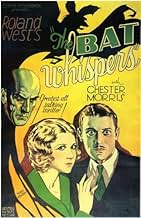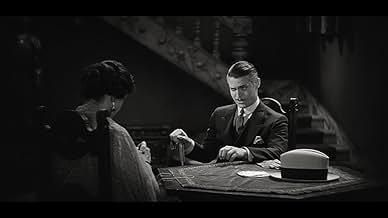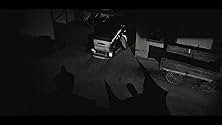IMDb RATING
6.3/10
1.3K
YOUR RATING
A master criminal terrorizes the occupants of an isolated country mansion.A master criminal terrorizes the occupants of an isolated country mansion.A master criminal terrorizes the occupants of an isolated country mansion.
- Director
- Writers
- Stars
- Awards
- 2 wins total
- Director
- Writers
- All cast & crew
- Production, box office & more at IMDbPro
Featured reviews
Roland West's THE BAT WHISPERS was based on a hugely successful Broadway play, The Bat, widely credited for having created the vogue for thriller plays in the 1920's. (The 1927 production "Dracula" which starred Bela Lugosi on stage was part of the mystery vogue, and led directly to the 1930 Universal film which kicked off the 30's cycle of horror movies). West filmed The Bat in 1926 as a silent, with great success. The 1930 remake was a large production, shot simultaneously in standard 35mm and a new widescreen 65mm process. Theater owners largely rejected the expense of installing 65mm equipment, and most people who saw this film on its release saw the 35mm version.
Among them was Bob Kane, who credited it as a major influence in his creation of Batman in the late 30's. It's easy to see why. This is a stunning looking film (I'm referring to the 35mm version, which I saw at the 2004 UCLA Festival of Preservation) gorgeously photographed by Ray June. In an old dark house where the lights are constantly going off, and lighting is frequently provided by candles, or lightning, bizarre lighting effects start to become the norm, and the dramatic possibilities take off. The director used every conceivable angle to keep things visually lively, mirroring the ridiculous complexity of the plot with a visual complexity that always keeps the viewer slightly off balance.
Much has been made of the sweeping camera moves and the use of miniatures. The miniatures are a bit obvious, but their intent remains effective if you're willing to go with it. (Being willing to "go with it" is pretty much a necessity in general for this film, which was a wild and unrealistic ride in its time, and deliberately so.) The photography benefits from a number of technical innovations, including a lightweight camera dolly invented for this production that allowed the camera to be moved 18 feet vertically in a matter of moments.
The performances - both comic and dramatic characters - are deliberately hokey, very stagey turns that were the standard for this genre. Much of Chester Morris' mugging and squinting, however, are attributable to the violently bright underlighting that was used in his closeups, which eventually scorched his retinas (a condition which became known as Klieg Eye). Within that context, they are wonderful performances. Morris is particularly engaging, as is Grayce Hampton as the patrician Cornelia Van Gorder, the middle-aged spinster who refuses to be scared out of the house. (Hampton appears to be a very capable stage actress, and offers perhaps the most natural performance in the film. She had made one previous film in 1916 and made numerous subsequent ones, usually in bit parts, until she was nearly 80.) Her no-nonsense dowager centers the film perfectly, keeping the other characters (and performances) from plunging completely off the deep end.
The plot? A master criminal, The Bat, is on the loose, a half-million dollars have been stolen from a bank by somebody else, and The Bat is trying to get it. The money has apparently been brought to a lonely mansion in a rural town (apparently somewhere on then-rural Long Island) where a middle-aged woman and her made are renting for the summer. Someone is trying to scare her out of the house, so she has sent for detectives. From there, anything goes.
Among them was Bob Kane, who credited it as a major influence in his creation of Batman in the late 30's. It's easy to see why. This is a stunning looking film (I'm referring to the 35mm version, which I saw at the 2004 UCLA Festival of Preservation) gorgeously photographed by Ray June. In an old dark house where the lights are constantly going off, and lighting is frequently provided by candles, or lightning, bizarre lighting effects start to become the norm, and the dramatic possibilities take off. The director used every conceivable angle to keep things visually lively, mirroring the ridiculous complexity of the plot with a visual complexity that always keeps the viewer slightly off balance.
Much has been made of the sweeping camera moves and the use of miniatures. The miniatures are a bit obvious, but their intent remains effective if you're willing to go with it. (Being willing to "go with it" is pretty much a necessity in general for this film, which was a wild and unrealistic ride in its time, and deliberately so.) The photography benefits from a number of technical innovations, including a lightweight camera dolly invented for this production that allowed the camera to be moved 18 feet vertically in a matter of moments.
The performances - both comic and dramatic characters - are deliberately hokey, very stagey turns that were the standard for this genre. Much of Chester Morris' mugging and squinting, however, are attributable to the violently bright underlighting that was used in his closeups, which eventually scorched his retinas (a condition which became known as Klieg Eye). Within that context, they are wonderful performances. Morris is particularly engaging, as is Grayce Hampton as the patrician Cornelia Van Gorder, the middle-aged spinster who refuses to be scared out of the house. (Hampton appears to be a very capable stage actress, and offers perhaps the most natural performance in the film. She had made one previous film in 1916 and made numerous subsequent ones, usually in bit parts, until she was nearly 80.) Her no-nonsense dowager centers the film perfectly, keeping the other characters (and performances) from plunging completely off the deep end.
The plot? A master criminal, The Bat, is on the loose, a half-million dollars have been stolen from a bank by somebody else, and The Bat is trying to get it. The money has apparently been brought to a lonely mansion in a rural town (apparently somewhere on then-rural Long Island) where a middle-aged woman and her made are renting for the summer. Someone is trying to scare her out of the house, so she has sent for detectives. From there, anything goes.
Roland West first filmed the story of the Bat, a killer that steals money and jewels for their value as well as for adventure, in 1926. He then made The Bat Whispers in 1930, which is a sound version of his silent film. The transition is not entirely smooth yet rewarding. Let me first state that the silent film is easily the superior of the two. The silent film had a much more creepier feeling to it. The acting was far superior, and the sets were incredible. West does duplicate much of the sets and shots that were in his first version. The acting, however, is not very good as it is obvious that sound pictures have not been around too long. West tries to accommodate that new innovation which sometimes results in stagey scenes and long dialogue sessions. Chester Morris is...well, to say the least...a ham. His performance is a bit over-the-top for me. He does show glimmers of talent though. The story is pretty much the same and that is the film's strength. It's a fun mystery that by today's standards will seem crude and silly, but taken in context of its time should provide some entertainment. Oddly enough, the mystery seemed less mysterious in this version. I knew who the killer was with ease(trying to distance myself from the memory of the first film as I did this). West again has some impressive camera shots. The opening scene of the bat stealing a jewel from an apartment high in the sky was incredible as was the journey of the bat over a bank and following a man with a lot of money. The camera work of West is innovative, and it is a pity that his life was cut short and we did not get a chance to see him employ his talents in other projects.
A tour-de-force of chases, shootouts, and robbery, as "The Bat" terrorizes a city, and particularly the renters of a mansion where he makes his hideout. Nearly everybody is a suspect, but the key lighting pretty much gives it away. Nonetheless, West keeps the pace moving so fast that we don't really have time to stop and think about much of anything. Features West's trademark effects with miniatures and wires.
Some remarkable photography (in 65mm, no less) in the disappearing silent gothic tradition makes this movie a link from the newly emerging horror scene to the old "haunted house with criminals" genre into which it more properly falls.
"Goofy gothic" excellence.
Some remarkable photography (in 65mm, no less) in the disappearing silent gothic tradition makes this movie a link from the newly emerging horror scene to the old "haunted house with criminals" genre into which it more properly falls.
"Goofy gothic" excellence.
Yes, this film is dated. The acting is beyond hammy; only in the early talkies did movies contain this kind of unabashedly theatrical performing. Just when you think Chester Morris couldn't possibly twist his mouth--or curl his eyebrow--or twirl his finger--in a new way, he surprises you and offers a wholly different mugging expression he hadn't pulled out before. Along with the acting, the genre (the creepy old house with hidden panels etc.) became old hat by 1950. So, all right, this movie is stilted and creaks. However, for a film antiquarian, this motion picture is a joy. Its sets and lighting are breathtaking, and one gathers from it why the play was one of the longest running on Broadway at the time. I'll take it over the Vincent Price remake, THE BAT, anyday and I love Vincent Price.
Great fun! The special effects are amazing for a 1930 movie. Miniaturized sets are used & although they're primitive by today's standards, keep in mind that this movie is over 70 years old. It's an excellent Old Dark House movie, complete with thunderstorms, secret passageways, a mysterious creature named "The Bat," comedic elements, a large old house, several murders, etc. It's been noted that the comic strip character, "Batman," owes some of his origins to "The Bat," & it's apparent in the outfit, the shadows cast from buildings, & in the name of the character itself. "The Bat" is indeed a pretty scary entity. The sound effects are good, camera work is excellent, & the ending is bizarre. It kept my interest throughout its 83 minutes. Well worth seeing for Old Dark House fans (this is one of the best). I rate it 9/10.
Did you know
- TriviaOne of only a handful of films to be shot in the widescreen Magnifilm 65mm format (other studios were also experimenting with other wide formats at the time). The expense of upgrading theaters with new screens and projectors - after just having to install sound equipment - coupled with the Depression and the December 1930 edict from the MPPDA that the film industry not cause "the public's curiosity to be aroused about any new innovations for at least two years" effectively killed the new format. Widescreen formats did not return until the middle of the 1950s out of the necessity to compete with television.
- GoofsAfter the bank robbery, there is a obvious slot in the "road" where the miniature car travels.
- Quotes
The Unknown: What I'd like to know is how did you get the dope from headquarters on this case?
Detective Anderson: The same way I get everything, with my mind. I've got the greatest brain that ever existed.
- Crazy creditsAfter the film an actor comes onto a movie house stage and implores the audience to withhold the identity of the bat from family and friends so they can also enjoy the movie.
- Alternate versionsThis film was shot in two versions with a different director of photography for each. One is in standard 35mm and the other in an early 65mm process. The 65mm version is considered "stagebound" (it was actually based on a popular play) while the 35mm version is considered more "cinematic". Prints of both versions still exist.
- ConnectionsFeatured in Cinemassacre Video: Bat-a-Thon (2008)
- How long is The Bat Whispers?Powered by Alexa
Details
- Release date
- Country of origin
- Language
- Also known as
- Roland West's The Bat Whispers
- Production company
- See more company credits at IMDbPro
- Runtime1 hour 24 minutes
- Color
- Sound mix
Contribute to this page
Suggest an edit or add missing content
































